Content [show]
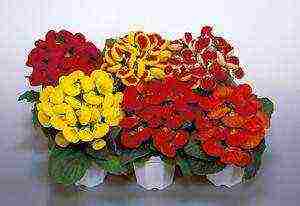 Calceolaria is one of the first to bloom in the garden or at home in early spring. This miniature plant is native to Central and South America. Its variegated flowers are shoe-shaped and can be red, white, orange or yellow. Caring for calceolaria is quite simple, so growers are happy to grow a plant at home. An important point in this is the process of flower reproduction, which requires compliance with certain rules.
Calceolaria is one of the first to bloom in the garden or at home in early spring. This miniature plant is native to Central and South America. Its variegated flowers are shoe-shaped and can be red, white, orange or yellow. Caring for calceolaria is quite simple, so growers are happy to grow a plant at home. An important point in this is the process of flower reproduction, which requires compliance with certain rules.
Description and varieties of calceolaria with a photo
Calceolaria flower belongs to perennial plants. In height and width, calceolaria has equal proportions in 20-30 cm... The bright green, corrugated leaves of the plant reach 5-10 cm in length. Unusual flowers, 2.5-6 cm in size, consist, as it were, of two lips. One of them is small and almost imperceptible, and the other is large, spherical, inflated. On one plant, up to fifty flowers can bloom at once. Calceolaria blooms for three to five weeks in April or May.
Calceolaria - species
The following types of plants are most popular:
-
 Calceolaria purpurea is a herbaceous perennial growing up to 50 cm. The plant is covered with basal leaves jagged at the edges. The flowers are distinguished by an oblong lower lip and a reddish-purple color.
Calceolaria purpurea is a herbaceous perennial growing up to 50 cm. The plant is covered with basal leaves jagged at the edges. The flowers are distinguished by an oblong lower lip and a reddish-purple color. - Calceolaria Mexican can grow from 20-50 cm. It all depends on the growing conditions. It blooms with pale yellow flowers, the diameter of which is about 5 cm.
- Calceolaria wrinkled in height grows to one and a half meters. It has small leaves and small yellow flowers with brown spots. Blooming wrinkled calceolaria looks like a yellow cloud.
- Hybrid calceolaria is a type of plant, under the name of which varieties similar in shape are combined. Basically, they differ only in the color of the flowers. The most common shades are yellow, red and orange. Flowers may have various blots, strokes, streaks or blotches of a different color. The most popular hybrid is the Dundee variety. This graceful plant blooms beautifully with red flowers.
Caring for calceolaria at home
When growing a plant, the most difficult thing is providing suitable conditions for him... The fact is that the flower does not like dry air and heat. In room conditions, it is almost always hot in summer, and heating devices dry the air in winter. Therefore, when caring for calceolaria, you must follow some rules.
Lighting and growing temperature
 The plant is recommended to be kept in a well-lit place. Make sure that it is not exposed to direct sunlight.The flower pot can be placed on northern, western or eastern windowsills.
The plant is recommended to be kept in a well-lit place. Make sure that it is not exposed to direct sunlight.The flower pot can be placed on northern, western or eastern windowsills.
The room temperature should be from + 14C to + 16C... At higher temperatures, calceolaria will bloom less, be affected by pests and hurt. In winter, the air temperature in room conditions should be no more than + 12C.
In the summer, the flower can be displayed on a loggia, balcony or veranda. The place should be protected from direct sunlight and wind.
In autumn and winter, the plant needs to be illuminated using fluorescent lamps. In the spring, when calceolaria begins to bloom, it will need a little shading.
Air humidity
The plant loves high humidity. However, in no case should it be sprayed, since water drops can damage the soft edge of the leaves.
To increase the humidity around the flower, it is recommended to place the pot on a pallet. with wet expanded clay, peat or moss... Some growers put pots in pots, filling the space between them with moistened peat.
Watering and feeding
During the dormant period, the plant is watered only as needed, that is, when the soil dries out. As soon as new growth begins to grow, the frequency of watering increases. Especially it is necessary to monitor the moisture content of the soil during the flowering period. Dried topsoil means the plant needs to be watered urgently. After flowering, you need to water the plant less often. Watering calceolaria is necessary with settled water at room temperature.
A young plant transplanted into a pot needs to be fed with complex mineral fertilizers in two weeks. Such dressings are carried out every ten days until the end of flowering.
Calceolaria care after flowering
A flower, even at home, grown as an annual plant... In order for the bush to bloom next year, it must be saved:
-
 After flowering, the shoots are cut off and the flower is removed to a darkened cool room for one and a half to two months.
After flowering, the shoots are cut off and the flower is removed to a darkened cool room for one and a half to two months. - It is necessary to ensure that the earthen lump does not dry out.
- With the emergence of young shoots, the flower pot is exposed in a well-lit place.
Such a plant will begin to bloom in February or March, that is, two months earlier than grown calceolaria from seeds. The bush will stretch out, and its decorative effect will be lost.
Reproduction of calceolaria
The plant reproduces in two ways:
- seeds;
- by cuttings.
Growing from seeds
The timing of sowing seeds indoors depends on when you want the flower to bloom. For spring flowering, planting should be done in June, and for autumn flowering - in March.
For sowing seeds you need prepare peat soilmixed with sand (7: 1). However, calceolaria does not like sour peat, so it is recommended to add ground chalk to it. About twenty grams of chalk is added to one kilogram of peat. The resulting soil must be well calcined before use.
Calceolaria seeds are very small, so they are simply scattered over the soil surface. You do not need to sprinkle them with anything. It is recommended to put a wet piece of paper on top, moistening it regularly. You need to keep crops in a warm room with a temperature of at least + 18C.
The first seedlings should appear in about two weeks. They should be watered between rows, gently pouring water in a thin stream. As soon as two true leaves appear on the seedlings, they must be dived. In order for the processes to take root well, they can be covered with plastic or glass. Every day, the seedlings need to be ventilated, especially after condensation has accumulated on the glass. Peat should always be moist.
Two months later, the second picking of seedlings is carried out in pots with a diameter of 9-11 cm... Immediately after transplanting, the plant is pinched. Only two or three pairs of leaves should remain on the bush. After a while, young shoots will begin to appear.
Already matured plants are transplanted into flower pots. The soil for this must be heavier and more nutritious.To prepare it, you will need to prepare:
- turf - 2 parts;
- humus - 2 parts;
- peat - 2 parts;
- sand - 1 part.
Calceolaria will bloom, subject to all the rules of cultivation, in 8-10 months from the moment of sowing the seeds.
Cuttings
Cuttings cut after flowering you can try to root... The optimal months for cuttings are February, March and August. The shoots are dipped in a special rooting powder and planted in a nutritious soil mixture. For the first time, it is recommended to cover them on top with a plastic bag or glass container. In the new place, the cuttings will take root for about two months. To make the calceolaria bush fluffy, several scraps are planted in one pot.
Possible growing difficulties
Calceolaria is picky enough, therefore, in room conditions, especially with improper care, can be affected by pests and diseases.
-
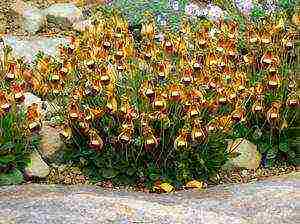 Most often, the plant affects whitefly and aphids. If there are still few pests, then you can try to collect them by hand and destroy them. Otherwise, the bush will need to be treated with special chemicals.
Most often, the plant affects whitefly and aphids. If there are still few pests, then you can try to collect them by hand and destroy them. Otherwise, the bush will need to be treated with special chemicals. - Gray rot is very dangerous for the plant. This disease occurs as a result of prolonged waterlogging of the soil at low air temperatures or excessive concentration of nitrogen in fertilizers. Heavily affected areas should be removed immediately, and the plant itself should be sprayed with cuprascat, topaz, oxychom or Bordeaux liquid. Medications for the treatment of gray mold must contain copper.
Calceolaria reacts to non-compliance with growing conditions and rules for the care of yellowing or wilting of foliage, falling off flower ovaries, rapid aging or even death of the bush.
Despite the difficulties of growing calceolaria, its decorative effect and beautiful flowering with unusual flowers makes the flower a welcome guest both on window sills and in personal plots.
Calceolaria flower
The genus Calceolaria includes approximately 400 species of plants from the family of the norichnik family, which are successfully grown with home care. In the wild, the plant is most often found in Central and South America.
General information
Basically, the plant grows as a grass, shrub or subshrub with whorled or opposite leaves. The flower is a four-membered calyx with a swollen bright and two-lipped corolla, in which 2-3 stamens are located. The fruit is in the shape of a capsule.
Many species are decorative, creating numerous garden varieties, used species hybrids: crenatiflora, arachnoidea, corymbosa, etc. Hybrid plant forms have red, orange, yellow and purple colors of flowers, with a shaded or spotted corolla, which are most often grown in a cool greenhouse, and propagated by cuttings or seeds.
Calceolaria is classified as an ornamental flowering plant, although it is quite difficult for her to provide care at home, due to the fact that she loves cool content. The flowers of this plant are very peculiar in shape, two-lipped and bubbly, the upper lip is barely noticeable, very small in size, but the lower lip is spherical and swollen, rather large in size. The flowering period takes place from March to June, for one month, at this moment from 18 to 55 flowers appear on the plant, which are very often covered with various dots and spots.
to the table of contents
Varieties and types
Hybrid calceolaria under this name many varieties of this plant are united, which in particular have a very attractive appearance with soft and delicate pubescent leaves of a light green color and original flowers of a variety of colors, ranging from pure white to orange. In indoor cultivation, it has the form of a small bush that reaches up to 50 centimeters in height.
Calceolaria purpurea found in the wild in Chile, as a perennial herb, reaching up to 50 centimeters in height. Basal leaves are pointed, spatulate, serrated along the edge. Small flowers with a reddish or purple tint, with an oblong, furrowed lower lip.
to the table of contents
Calceolaria home care
The plant is good for diffused bright lighting, but it should be shaded from direct sunlight. Feels good when placed near an east, west or north window, if this is a south-facing window, the plant should be shaded using translucent paper or fabric. The plant should be shaded during the flowering period. In the autumn-winter period, you can provide the plant with additional lighting with fluorescent lamps.
At any time of the year, the calceolaria plant is best kept in a moderate temperature of 14 to 17 degrees.
During the flowering period, the plants are watered with settled and soft water, after the top layer of the soil has dried, and the water is not allowed to melt in the pan. At the end of the flowering period, watering is reduced, moistening the soil only occasionally, but at the same time, the earthen coma is not allowed to completely dry out. When new growth appears, watering should be gradually resumed.
The plant needs to provide increased air humidity. At the same time, it is not recommended to spray the plant. To provide the necessary moisture, the pot with the plant can be placed in a tray with wet expanded clay, peat or pebbles, without allowing the pot to touch the water. It is recommended to grow the plant in pots that are inserted into the planter. This will make it possible to fill the space between the vessels with peat, which must be constantly moistened.
Calceolaria should be fertilized after two weeks, after planting the plant in a bowl, and continue to do this until the flowering period. Each feeding takes place once every two weeks with mineral fertilizers.
After the end of the flowering period, the plant can be cut off and left for 1.5-2 months, in a shaded and cool place, occasionally watering to prevent the soil from drying out completely. After the growth of new growth, the plant should be returned to a lighted place, where it will begin to bloom. The flowering period will start approximately 2 months earlier than plants grown from seeds, but in this case, such cultivation contributes to the stretching of the plant and the loss of decorativeness. For this reason, it is best to grow the plant annually from seed.
Plants also lose their decorative effect with age, so it is best not to replant them, but to replace them with new ones.
to the table of contents
Calceolaria growing from seeds at home
Seeds are sown in March, to obtain flowering in the autumn, but if you want the plants to bloom in the spring, they should be sown in June.
The seeds are quite small, 1 gram contains about 30 thousand pieces, they should be sown on the surface of the soil. After that, the crops must be covered with paper, periodically moistening it. And already, like seedlings, two real leaves will appear, they must be dived into the prepared substrate from equal parts of deciduous soil, humus soil and peat soil, as well as ½ part of sand.
Also, calceolaria seeds germinate well in peat. To ensure the flowering of plants in March, the seeds should be planted on June 5-15 in litter peat, which is previously disinfected from rot by heating to 90-100 degrees. To reduce the acidity of the peat, it is necessary to add ground chalk, approximately 15-20 grams per 1 kilogram of peat.
Then add 1 part of sand to the substrate, approximately 7 parts of peat and mix well. Seeds are sown randomly, without sprinkling, after which the crops are covered with glass or polyethylene.If condensation forms on the inside of polyethylene or glass, the shelter must be turned over to avoid moisture ingress on the plants. Subsequently, the peat is kept moist.
Plants dive a second time, after the formation of a rosette, transplanting them into 7 cm pots and placing them on light windowsills. And already in September, the plants are pinched, leaving 2-3 pairs of leaves, from the sinuses of which shoots will appear and transplanted again, increasing the size of the pot by 2-4 centimeters
Calceolaria bushes can also be formed by pinching, removing lateral shoots that grow from the leaf axils.
In the period from January to February, the plants are replanted again, in a large bowl with more nutritious and heavy soil. A slightly acidic humus soil with a pH of about 5.5 is suitable for this.
When compiling the substrate ourselves, take equal parts of peat land, sod land, and humus soil, as well as ½ part of sand, with the addition of complete mineral fertilizer, at the rate of 2-3 grams per 1 kilogram of substrate. The flowering of the plant occurs in 8-10 months from the moment of sowing the seeds.
to the table of contents
Possible difficulties
- The leaves wither, and the plant ages quickly, due to insufficient moisture and high temperature of the content.
- The plant requires annual replacement - it will be propagated by seeds or an already flowering specimen is acquired, without leaving the old plant for the next year.
- Damaged by: spider mites, mealybugs, whiteflies and scabbards, this happens especially often when leaving at home with a temperature of 20 to 25 degrees in a poorly ventilated room.
to the table of contents
A herbaceous and abundantly flowering plant like calceolaria at home it is grown as an annual or biennial. Its popularity is associated with very spectacular flowers, which have an unusual shape, reminiscent of a "purse" or "shoe". So, these bright flowers are double-lipped, the upper lip of which is extremely small, and the lower one is large, spherical, swollen.
The genus Calceolaria has about 400 species of the norichnik families. In English taxonomy, they are classified into the Calceolariaceae family. In the wild, such a flower can be found in Central and South America. "Calceolaria" is translated from Latin as "small shoe".
This genus includes shrubs, grasses, shrubs, in which the leaves are opposite or whorled. The flower calyx is four-membered, and the corolla is swollen, two-lipped (with the upper lip, as a rule, smaller). Has 2-3 stamens. The fruit is presented in the form of a box.

In calceolaria, most of the species are very beautiful and are grown as ornamental plants. Hybrid garden varieties were created from species such as: C. arachnoidea, C. corymbosa, C. crenatiflora, and others. For cultivation in cool greenhouses, as a rule, hybrids are chosen, the flowers of which are painted in purple, orange, yellow or red, and their corollas can also be shaded or with specks. For their reproduction, cuttings or seeds are used.
This flowering plant will delight you with its flowers in springtime, while you should know that it is problematic to grow it at home, as it prefers cool places. Its spherical, bright, bubbly flowers stand out in particular. Flowers often have many different dots and spots. As a rule, calceolaria blooms from March to June. Flowering continues for 4 weeks. One plant can produce 18–55 flowers.

Care features
Temperature regime
This flower needs coolness (12-16 degrees). If the air temperature is too high, flowers or buds may fall off.
Illumination
Loves well-lit places, but the light should be diffused. Requires shading from direct sunlight.It is best to put it on a windowsill located in the northern, eastern or northwestern part of the room.
How to water
Watering should be abundant. Do not allow the earth to dry out.
Humidity
The flower needs very high humidity. It is recommended to pour small pebbles or expanded clay into a wide pallet, pour water, and put a flower pot on top. When spraying, try to keep the liquid out of the pubescent leaves. Only flowers are sprayed.

How to transplant
The soil mixture consists of leaf, peat, turf soil, and sand, mixed in a ratio of 3: 2: 3: 1. When calceolaria has finished blooming, you can throw it away.
How to propagate
You can grow this plant from seeds. To do this, sowing is carried out from May to July, while the seeds are not sprinkled with earth. Double pick required. For germination, the seeds need to provide a temperature of about 18 degrees. But it is difficult to grow this flower in indoor conditions; it is better to purchase a ready-made one in a special store.
How to care for calceolaria correctly
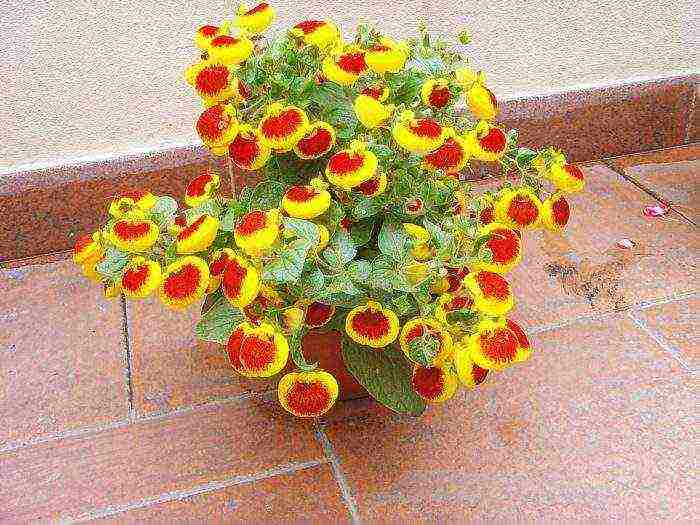
Such a plant simply needs diffused light, and it does not tolerate the direct rays of the sun, from which it must be shaded. Grows well on window sills located on the west or east window. If calceolaria is placed on a southern windowsill, then it needs good shading, which can be made from paper or a translucent material (for example, tulle, gauze, tracing paper, and so on). Also feels great on the northern windowsill. When the plant begins to bloom, it will not need very much shading. In the autumn-winter period, it is recommended to supplement the flower with fluorescent lamps.
In order for calceolaria to grow and develop normally, it needs the air temperature in the room to be no higher than 12-16 degrees, and, importantly, at any time of the year.
During the flowering period, watering should be regular. To do this, you need to use soft and always settled water. Moisten the soil immediately after the top layer dries. After some time after watering, be sure to pour out the liquid that has accumulated in the pan. When the flowering is over, you need to water the calceolaria very rarely and little, but make sure that the earthen lump does not dry out. After fresh growth appears, they gradually return to the previous irrigation regime.
This flower simply needs a very high air humidity, but at the same time, experts do not recommend moisturizing it from a spray bottle. In order to achieve the required humidity, the pot with the plant is placed on a pallet, into which water is poured and pebbles are placed, and you can also use moistened peat or expanded clay. It is also advised to place the flower pot in a flower pot, and fill the remaining space between the 2 vessels with moist peat (it is moistened regularly).
The plant is fed for the first time after 2 weeks have passed after the flower is transplanted into a permanent pot. Mineral fertilizers are applied 2 times a month.
After this plant has faded, its aerial part can be completely removed. Then the pot needs to be rearranged for 6-8 weeks in a dark, cool place. Watering is rarely necessary, but the soil should not completely dry out. After the young growth appears, the pot is placed in a well-lit place, and after a while the calceolaria blooms. As a rule, such flowers begin to bloom a couple of months earlier than those grown from seeds. However, they are characterized by a loss of decorativeness, due to the fact that they are strongly stretched.
Over time, calceolaria will surely lose its decorative effect and quickly enough. To always have beautiful plants, you do not need to transplant them, but replace them with new ones.

How to propagate calceolaria
For the propagation of such flowers, seeds are used. If you want flowering to come in the spring, then you need to sow them in June, and if in the fall, then in March.
Calceolaria seeds are very small in size, so, in 1 gram, there are about 30 thousand pieces. Sowing is carried out directly on the soil surface; additional dusting with earth is not required. Paper is placed on top of the soil, and it must be systematically moistened. A pick is made after the seedlings grow 2 true leaves. To create a suitable soil mixture, it is necessary to mix deciduous, humus and peat soil, as well as sand in a ratio of 2: 2: 2: 1.
Also, the seeds germinate well on peat. If you want flowering to come in mid-March, then sowing should be done from 5 to 15 July. To do this, use litter peat, disinfected from rot by heating to 90-100 degrees. To lower the acidity of peat, chalk is used. To do this, it is added to the substrate. 15-20 grams of ground chalk is taken per kilogram of peat. Also, peat is mixed with sand in a ratio of 7: 1. In the resulting mixture, the seeds are sown. To do this, they are scattered over the surface and not sprinkled on top with a substrate. Next, the container is tightly covered with glass or film. When condensation accumulates on the inner surface of the covering material, it must be carefully turned over so that water does not get onto the seedlings. Be sure to keep the substrate moisture constant.
The second pick into pots with a diameter of 7 centimeters is made after the appearance of the outlet. Then they are placed on light-colored windowsills. At the beginning of autumn, another transplant is carried out, and pots with a diameter of 9-11 centimeters are used for it. Do not forget to pinch the calceolaria before this transplant, only 2 or 3 pairs of leaves should remain, and lateral shoots will begin to grow from their sinuses.
You can also form a bush using pinching. To do this, you need to carefully remove the lateral shoots that are formed from the axils of the leaves.
Another transplant, already in larger pots, is carried out from January to February. For this, a nutritious and heavy soil mixture is used, consisting of humus, turf and peat soil, as well as sand, mixed in a ratio of 2: 2: 2: 1. Also, do not forget to add 2-3 grams of complex mineral fertilizer per kilogram of the mixture. This humus substrate must be slightly acidic (approximately pH 5.5).
Flowering occurs 8–10 months after sowing the seeds.

Growing difficulties
These flowers need to be replaced annually with new ones. It is not advisable to leave them for the next year.
The leaves wither and calceolaria ages quickly if the indoor air is too hot and dry.
Main types
Calceolaria mexicana (Calceolaria mexicana)

Such plants are difficult to combine with others. So, this type of calceolaria has very small flowers (diameter 5 millimeters) of a light yellow hue. They look most advantageous in the border together with flowers with decorative leaves, as well as in the composition located on the bank of the stream. Calceolaria corollas then look like little lanterns.
Under different conditions of detention, the height of the bush may vary (from 20 to 50 centimeters). Taller bushes will be in a moist, shaded area with nutritious soil. In the wild, Mexican calceolaria can be found on the wooded slopes of the mountains of Mexico, because it is a thermophilic plant. But at the same time, the bright light of the sun does not tolerate well, only if it is provided with good watering. This flower almost always bears fruit abundantly and has a large number of seeds.
Calceolaria wrinkled - Calceolaria rugosa
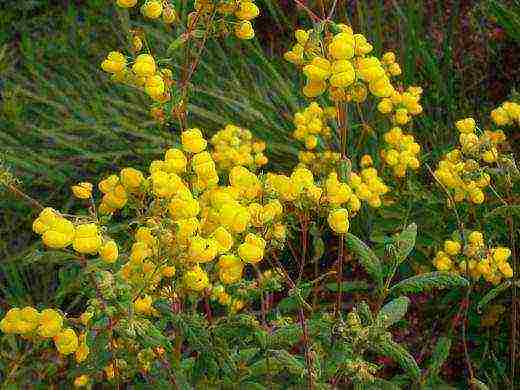
This calceolaria is distinguished by its elegance and originality. Chile is her homeland.
This herbaceous perennial plant, which has a very branched erect stem (25-50 centimeters high), is most often grown as an annual. Small (1.5–2 cm in diameter) flowers have a bright yellow color. But there are forms that have brownish dots. Small leaves are collected in rosettes.If you sow this plant as usual, then it begins to bloom as early as June and continues - until the very frost. If there is a desire for this flower to bloom in the month of April, then it must be grown in containers.
Main varieties:
- Goldbukett - the plant has large flowers, and the height of a rather strong bush reaches 25-30 centimeters;
- Triomphe de Versailles - has small flowers, and the height of a fast-growing bush reaches 35-50 centimeters;
- Sunset (Calceolaria x hybridus) is a very spectacular plant that can be grown both at home and in the garden. On each rosette, consisting of dark green leathery leaves, about a dozen short peduncles appear. In this case, bell flowers can be colored orange, yellow or red. The bushes reach a height of 15–20 centimeters. They do not die with a short-term drop in temperature to minus 5 degrees.
Video review
Calceolaria is a herbaceous, abundantly flowering plant that is grown in room culture as an annual or biennial. It conquers with its distinctively shaped bright double-lipped flowers, and the lower lip is large, swollen, spherical, and the upper lip is extremely small, barely noticeable. By their outward resemblance, the people called them "shoes" or "wallets".
 Calceolaria Fothergill, cultivar ‘Walter Shrimpton’
Calceolaria Fothergill, cultivar ‘Walter Shrimpton’
The genus Calceolaria (Calceolaria) includes about 400 species of the family norichnikovye. In English taxonomy, they are classified into the Calceolariaceae family. The homeland of plants is South and Central America. Translated from Latin, the word "calceolaria" means "little shoe".
Representatives of the genus are grasses, shrubs and shrubs with opposite or whorled leaves. Flowers with a four-membered calyx and a bright two-lipped, swollen corolla (the lower lip is usually larger). Stamens 2 or 3. Fruit - capsule.
Many types are decorative. When creating numerous garden varieties of calceolaria, we used hybrids of the species C. corymbosa, C. arachnoidea, C. crenatiflora, etc. Hybrid calceolaria with yellow, orange, red, purple flowers, as well as with a spotted or shaded corolla, are grown in cool greenhouses, propagated by seeds cuttings.
Calceolaria is one of the favorite spring flowering plants, although it is rather difficult to grow and breed it indoors (the plant prefers cool rooms). Calceolaria flowers are very peculiar in shape - blistery and two-lipped (the lower lip is large, swollen, spherical, and the upper lip is extremely small, barely noticeable). Flowers are often covered with various spots and dots. The flowering period lasts from March to June for one month. The plant has from 18 to 55 flowers.
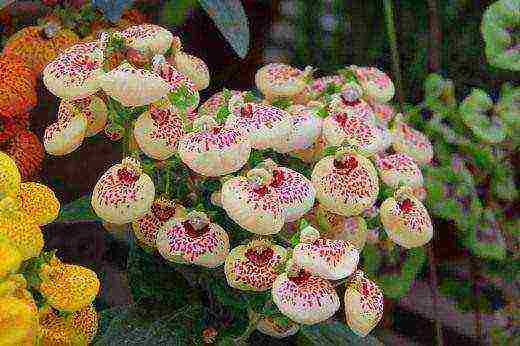 Calceolaria
Calceolaria
Growing features
Temperature: Calceolaria likes a cool room, 12-16 ° C. In too warm rooms, it drops buds or flowers.
Lighting: Preferred bright diffused light, cannot tolerate direct sunlight. It is good to place on the windowsill of the east, north or northwest window.
Watering: Abundant, earthen lump should not dry out.
Air humidity: Calceolaria requires very high air humidity, for this pots with plants are placed on a wide tray with pebbles or expanded clay. The pubescent leaves of calceolaria do not like water getting on them, so this plant is sprayed, trying to keep moisture only on the flowers.
Transfer: Soil - 2 parts sod, 2 parts leaf, 1 part peat and 1/2 part sand. After flowering, the plant is discarded.
Reproduction: Seeds, sown in May-July, without sprinkling with soil on top and with a double pick. Calceolaria seeds germinate at a temperature of about 18 ° C. However, growing calceolaria at home is a rather troublesome task, it is easier to purchase an already flowering plant.
 Calceolaria
Calceolaria
Calceolaria care
Calceolaria prefers diffused light; the plant is shaded from direct sunlight. Suitable for growing near western and eastern windows. At the southern windows, calceolaria should be shaded from the direct sun using a translucent fabric or paper (gauze, tulle, tracing paper). Grows well at the north window. During the flowering period, the plant needs a little shading. In autumn and winter, you can use additional fluorescent lighting.
The temperature of the content of calceolaria in all seasons is preferable to be moderate, in the region of 12-16 ° C.
During flowering, the plant is watered regularly, with soft, settled water, as the upper layer of the substrate dries up, preventing water from stagnating in the pan. After flowering, watering should be reduced, occasionally moistening the soil and preventing the substrate from completely drying out. When new growth begins to grow, watering is gradually resumed.
Calceolaria needs high air humidity. It is not recommended to spray the plant.
To ensure sufficient moisture, the plant pot is placed on a tray filled with water and pebbles or wet peat, expanded clay. It is advisable to grow calceolaria in pots inserted into planters. The space between the two vessels is filled with peat, which must be constantly moistened.
Feeding begins two weeks after planting in pots and continues until flowering. They are fed every 2 weeks with mineral fertilizers.
After flowering, calceolaria can be cut off and put for 1.5-2 months in a cool, shaded place, occasionally moistening the soil (the earthen coma must not be allowed to dry completely). When the shoots begin to grow, the plants are placed in a lighted place where they bloom. Flowering begins 2 months earlier than in plants grown from seeds, but they stretch out somewhat and lose the decorative effect inherent in young calceolaria. Therefore, it is better to grow it annually from seed.
Since the plant quickly loses its decorative effect with age, it should not be transplanted, but should be replaced with a new one.
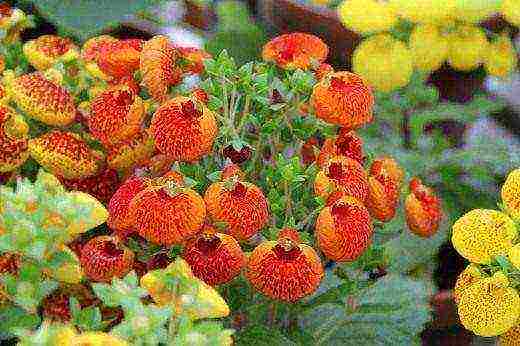 Calceolaria
Calceolaria
Reproduction of calceolaria
Calceolaria is propagated by seeds.
For autumn flowering, they are sown in March, for spring - in June.
Small seeds (in 1 g about 30 thousand pieces) are sown on the surface of the substrate, they are not covered with soil. Crops are covered with paper, which is periodically moistened. When the seedlings grow two true leaves, they dive. At the same time, for the preparation of the earthen mixture, take 2 parts of humus, deciduous and peat soil and 1 part of sand.
Calceolaria seeds germinate well on peat. In order for the plants to bloom in mid-March, seeds are sown on July 5-15 in litter peat, previously disinfected from rot by heating to 90-100 ° C. To reduce acidity, ground chalk is added to the peat (15-20 g per 1 kg of peat). For 7 parts of peat, take 1 part of sand. Mix the substrate well. Seeds are sown randomly, without sprinkling with peat. The crops are covered with plastic wrap or glass. If condensation forms on the inside of the glass or film, the shelter must be turned over, preventing moisture from entering the plants. In the future, it is necessary to ensure that the peat is always moist.
After the formation of the rosette, the plants are dived a second time, transplanted into 7-centimeter pots and placed on light windows. In September, they are transplanted again into 9-11 cm pots. Before the second transplant, the plants are pinched, leaving 2-3 pairs of leaves, from the axils of which lateral shoots appear.
Calceolaria bushes are also formed by pinching, i.e. removal of lateral shoots growing from the leaf axils.
In January - February, they are transplanted into large pots with a heavier and more nutritious earthen mixture. For grown plants, a humus, slightly acidic (pH about 5.5) substrate is suitable.To compose the substrate, you can take 2 parts of sod, humus and peat land and 1 part of sand with the addition of complete mineral fertilizer at the rate of 2-3 g per 1 kg of the mixture. Calceolaria blooms 8-10 months after sowing the seeds.
Possible difficulties
Every year, the plants are replaced - they are propagated by seeds or they acquire already flowering specimens, without leaving them for the next year.
At high temperatures and lack of moisture, the leaves wither and the plant ages quickly.
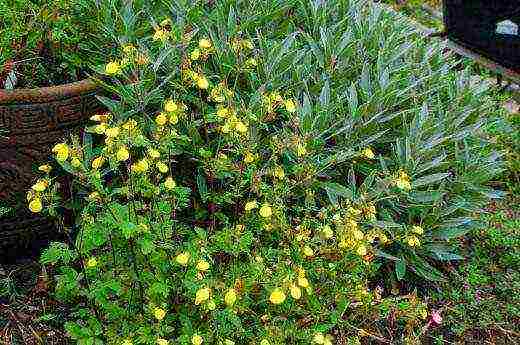 Calceolaria mexican
Calceolaria mexican
Views
Calceolaria Mexican - Calceolaria mexicana
All types of calceolaria, due to their too bright colors, are difficult to combine with other plants. Calceolaria Mexican is no exception. Its small, with a diameter of only about 5 mm, light yellow flowers look spectacular only in a border with ornamental plants or in a composition located on the bank of a stream. In these cases, their corollas look like small Chinese lanterns.
Depending on the conditions, calceolaria bushes can reach a height of 20-50 cm. Naturally, in a humid, shaded place with fertile soil, they will be taller. In nature, this species grows on the wooded slopes of the mountains of Mexico, so it prefers warmth. However, bright sunlight is well tolerated only with abundant watering. Plants usually bear fruit abundantly, producing many seeds.
Calceolaria wrinkled - Calceolaria rugosa
The original ornate plant, similar to a cloud of yellow drops, was brought to Europe from Chile.
A perennial herb, grown as an annual, has an erect, highly branched stem 25-50 cm high. Small leaves form a rosette. The flowers are small, 1.5 - 2 cm in diameter, pure yellow, in some hybrid forms with brown dots. With normal sowing, flowering lasts from June until frost. For early flowering in April, seedlings are grown in containers.
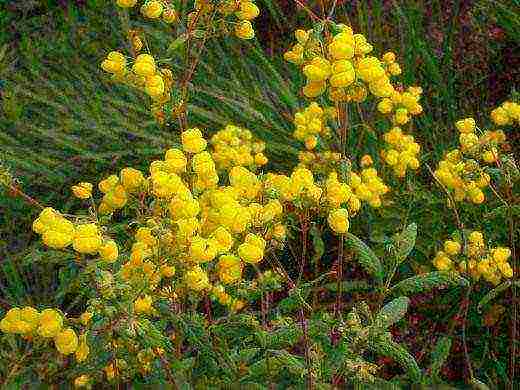 Calceolaria wrinkled
Calceolaria wrinkled
Varieties:
Goldbukett - large-flowered strong plants 25-30 cm high.
‘Triomphe de Versailles’ are small-flowered fast-growing plants 35-50 cm high.
Sunset (Calceolaria x hybridus) is a bright and elegant plant for home and garden! Each rosette of leathery dark green leaves forms up to 10 short peduncles with yellow, orange or red bell flowers. Height 15-20 cm. Withstands frosts down to -5 ° С.


